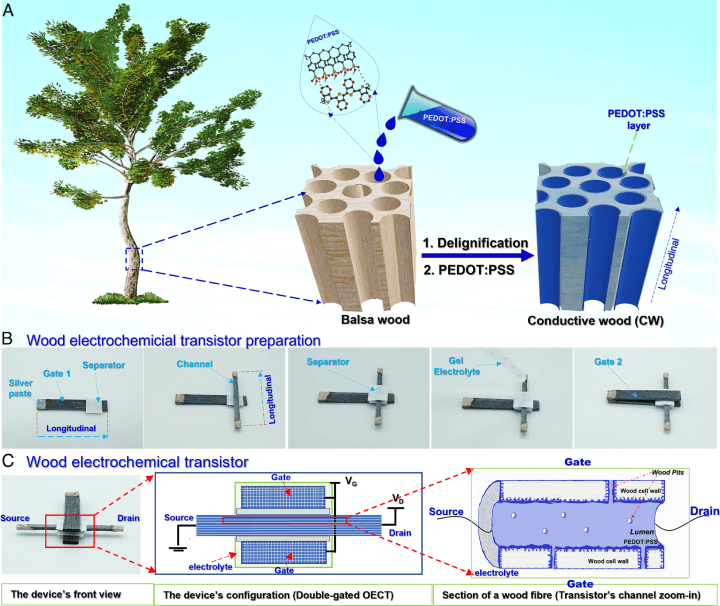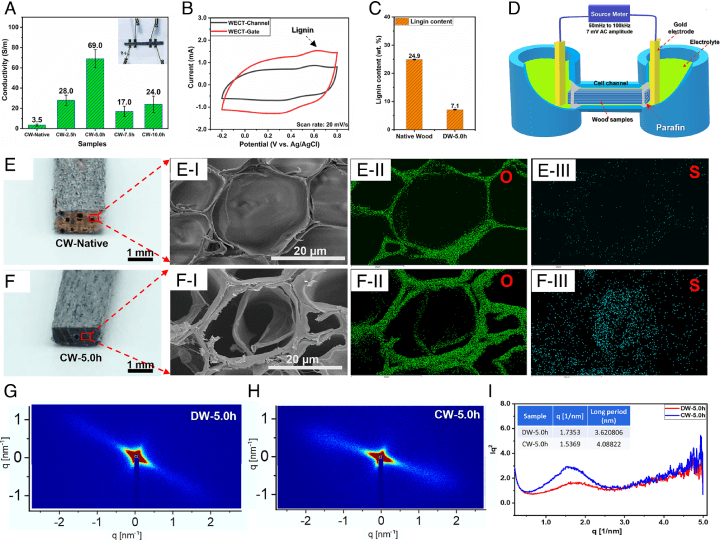Balsa Wood Transistors: A Game-Changer for Sustainable Electronics & Plant Integration
Environment | 04-05-2023 | By Robin Mitchell
In a more unusual direction, researchers recently demonstrated a functioning transistor made from balsa wood that they hope will allow for future sensors to be integrated inside living plants. What challenges does sensor integration into living plants present, what did the researchers create, and how could such sensors help with future environmental monitoring?
What challenges does sensor integration into living plants present?
Since the earliest civilisation, caring for the environment and understanding how it works have played an important role in our development. For example, recognising that scorched earth can help provide fertile lands has allowed farmers to increase crop yields, which in turn has helped to support larger populations. At the same time, understanding how pollination works with fruits and vegetables has helped to promote the environmental protection of natural habitats while continuing to discourage the use of pesticides.
Thanks to the rise of modern technologies (such as the Internet of Things (IoT) and Long Range (LoRa)), researchers are actively developing sensors to deploy at scale with the goal of gathering as much data as possible on plant growth, animal populations, migration patterns, and reforestation rates. But trying to install sensors for long-term uses faces a number of challenges, and if not addressed, can have serious consequences. For readers unfamiliar with IoT (Internet of Things) and LoRa (Long Range) technologies, these innovations have significantly expanded the potential for environmental monitoring. IoT refers to the network of interconnected physical devices that communicate and exchange data with each other, while LoRa is a wireless communication protocol specifically designed for low-power, long-range communication between devices. To learn more about IoT, you can visit this comprehensive guide from IBM, and for more information on LoRa, take a look at this article from Semtech.
One major challenge faced by sensor integration into living plants is that the plant being monitored can be negatively affected by the sensor. For example, inserting a copper nail into a tree will kill the tree as the copper is toxic. Thus, if a sensor that is inserted into a tree were to be damaged, it could also leech such chemicals, thereby killing the tree. This would be especially problematic when monitoring rare and old trees that become critical to local habitats and ecology.
Another challenge faced by sensors is their long-term environmental impact. As many modern electronics contain trace amounts of heavy metals, those that eventually become buried risk contaminating plants, animals, and, more importantly, underground water sources. Furthermore, electronic components are generally non-biodegradable, meaning that they can easily hang around for hundreds of years while posing a poison risk to animals that try to consume them.
Thus, the very tools that we use to understand and help the environment can very easily harm it.
Researchers create transistor out of wood
Over the years, researchers have explored countless materials in an effort to find new semiconductors in the hope of discovering new applications, such as flexible and disposable electronics. However, researchers from Linköping University in Sweden recently demonstrated a transistor made out of a material that probably wouldn’t have been the first choice for others; wood.

The preparation of conductive wood (A) and fabrication processes of the wood electrochemical transistor (B) are shown in schematic diagrams. (C) Moving from left to right, the WECT is depicted in a front-view photograph, followed by a front view of the WECT configuration and a zoomed-in conceptual view of the transistor's channel, which shows a section of a wood fiber with a PEDOT:PSS-coated cell wall and an electrolyte-transporting lumen. (Click to enlarge)
The new transistor utilises balsa wood as a structural medium, where heating and chemical processes are used to remove lignin, a binding substance found in wood. From there, the researchers then soaked the treated balsa wood in a solution containing conductive polymers that coat the lumina (tube-like structures that transport water), resulting in a conductivity of 69 S/m (Tran et al., Conclusions). Arranging a structure of three electrodes and two layers of separators soaked in a chemical electrolytic solution resulted in a device capable of amplifying a current.

(A) The researchers examined the conductivity of samples created using various delignification times, and used a four-point probe measurement setup. (B) They performed cyclic voltammetry on WECT-Channel and WECT-Gate samples. (C) Lignin content was compared between Native and DW-5.0h samples. (D) An illustration shows the setup for measuring ionic conductivity.
(E) and (F) display cross-sectional images of CW-Native and CW-5.0h samples, respectively. (E, I) and (F, I) are cross-sectional SEM images taken at the middle of supercritically point-dried CW-Native and CW-5.0h samples. (E, II) and (E, III) show the EDX elemental mapping of oxygen and sulfur in the corresponding SEM images of CW-Native, while (F, II) and (F, III) present the EDX elemental mapping of oxygen and sulfur in the corresponding SEM image of CW-5.0h.
(G) and (H) demonstrate the SAXS patterns of DW-5.0h and CW-5.0h samples, respectively. (I) The analysis results of 1D SAXS spectra for DW-5.0h and CW-5.0h are provided, along with the calculated figures for DW-5.0h and CW-5.0h as insets. (Click to enlarge)
During the development of the transistor, the researchers tried to use other woods, such as birch and ash but found that the low density of balsa wood provided the best results. Furthermore, the transistor developed has low switching times in the seconds, but as a concept device, the researchers found the results to be exciting when considering that wood, of all materials, was being used as a transistor.
How could such sensors help with future environmental monitoring?
While the transistor developed itself has little value, the fact that wood can be used as a switching device introduces numerous future possibilities. One such application that the researchers are now exploring is growing conductive elements inside living trees as they grow. If this can be achieved, it is possible to take internal electrical measurements of a plant without causing any harm via invasive electrodes. This could also be taken further by turning these conductive elements into sensors, such as thermocouples, strain gauges, and even toxic compound detectors.
The integration of wood-based sensors into living plants could revolutionise the way we monitor plant health and adapt to environmental changes. By harnessing the biodegradable nature of wood-based electronics, scientists could develop non-invasive, eco-friendly solutions to track plant growth, water consumption, and nutrient uptake. This new generation of sensors may help farmers optimise crop yields, conserve resources, and minimise the environmental impact of agricultural practices.
Furthermore, the biodegradable nature of the transistor demonstrates that future devices could very well be fully disposable, presenting less danger to the environment when buried or consumed. This ability will allow researchers to deploy sensors en-masse without having to worry about the long-term effects of their sensors.
Overall, what the researchers have demonstrated is truly exciting for the electronics industry and will undoubtedly have a lasting impact on future research. Hopefully, this wooden transistor won’t be like the wooden car that wouldn’t go!
Citations
Tran, V. C., Mastantuoni, G. G., Zabihipour, M., Li, L., Berglund, L., Berggren, M., Zhou, Q., & Engquist, I. (2023). Electrical current modulation in wood electrochemical transistor. Proceedings of the National Academy of Sciences, 120(18), e2218380120. https://doi.org/10.1073/pnas.2218380120

